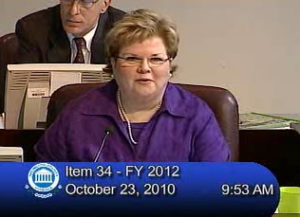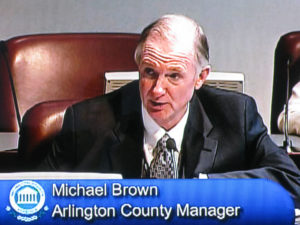 You might think that with another looming budget gap and talk of a new worldwide Age of Austerity, Arlington County would be looking at cutting employee compensation as a potential way to trim costs.
You might think that with another looming budget gap and talk of a new worldwide Age of Austerity, Arlington County would be looking at cutting employee compensation as a potential way to trim costs.
After all, every taxpayer in Arlington knows that our famously progressive county probably pays employees more than anyone else in the region, right?
Wrong.
Arlington is, in fact, still playing catchup with Fairfax and Alexandria compensation-wise, County Manager Barbara Donnellan told a group of Arlington County Civic Federation delegates Tuesday night.
Donnellan cited a study released last year which determined that while employee benefits were on par with Fairfax and Alexandria, Arlington’s two biggest competitors in the job market, employee salaries lagged in more than half the job categories examined.
Another such study will be conducted next year.
Donnellan said that Arlington will likely continue to grant merit-based step increases to employees in the upcoming budget. That, she said, should help Arlington compete with Fairfax, which has frozen step increases. Like Arlington, however, Alexandria is still granting pay raises.
“Overall, we’re trying to maintain competitiveness,” Donnellan said. Comparisons to the private sector and to similar jurisdictions in other parts of the country are generally not helpful, Donnellan said, because the county is drawing from a different pool of potential job applicants.
 As an example of one area where Arlington is struggling to fill jobs, Donnellan cited a recent recruiting drive by the police department.
As an example of one area where Arlington is struggling to fill jobs, Donnellan cited a recent recruiting drive by the police department.
Out of some 70 prospective applicants for a significant number of police vacancies (perhaps 20 to 30), only four were ultimately hired after a battery of physical and mental tests.
“Four doesn’t cut it,” Donnellan said, adding that more public safety recruiting classes will be necessary. In other job categories, she said, hiring is a mixed bag.
“We had a hiring freeze for two years, so when we do open up a job, we get a lot of applicants who are applying for it,” she said. “Are they the best and the brightest and fit exactly with the experience that we’re looking for? Not always. But we certainly have been able to capture some people in this downtime that are looking for a more stable environment to work in.”
 If you haven’t been able to make it to any of County Manager Barbara Donnellan’s in-person budget forums, here is your chance to learn about this year’s budget process without leaving your home or office.
If you haven’t been able to make it to any of County Manager Barbara Donnellan’s in-person budget forums, here is your chance to learn about this year’s budget process without leaving your home or office.








